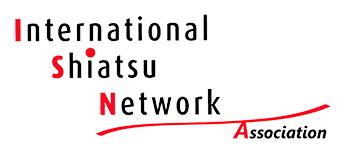Curriculum
1. Knowledge
The competences of the shiatsu practitioner include, depending on the specific shiatsu style,
the following:
- Philosophical and theoretical aspects of the East Asian health framework and their significance for the Shiatsu work
- Knowledge of the dependence of the practitioner’s attitude and its effect on the client
The concept of Yin & Yang - Systems of meridians and the psychic and physical functions of meridians
- The Five Elements and their dynamics
- The Hara and back areas
- The theory of Kyo & Jitsu
- Yu and Bo points
- History, theories, and systems of Shiatsu (for example the roots of Shiatsu and the various Shiatsu styles)
- Anatomic and physiological fundamentals in relation to contents specific to Shiatsu
Pathways of meridians - Localisation of Tsubos or points
- Functions of the organs according to East Asian theories
- Understanding of Ki
- Characteristics of Tsubos/points
Thenational shiatsu associations define the professional profile of shiatsu and competences,
which have to be gained in the training.
They supportand guarantee the quality of their members by demanding adequate standars
particularly respect oft he code of ethic.
2. Competences
The shiatsu student has learned the importance to be internally and externally focused and centred during the duration of the contact with the client.
Encounter
- Communicate with the client in an adequate manner
- Discuss the reasons for coming, the client’s requirements and wishes in relation to Shiatsu
- Potentially recognise and identify existing resources with the client
- Discuss the treatment in relation to the Five Elements
- Inform adequately about the fundamental aspects of East Asian philosophy in Shiatsu.
- Discuss the treatment style and possible treatment procedures with the client
- Discuss possible holistic approaches within the Shiatsu method and collect the client’s consent
- Discuss the treatment position, his/her limits with regard to touch, and aspects of clothing
- Perform a Shiatsu specific energetic evaluation on the basis of conversation, observation and palpation of the energetic areas
- Master and combine the Shiatsu specific methods of assessment, for example:
o Bo Shin
o Mon Shin
o Bun Shin
o Setsu Shin
o Evaluation in the Hara and on the back
o Kyo & Jitsu
o Yu and Bo points - Plan the treatment on the basis of the Shiatsu specific energetic evaluation and the assessments and wishes collected through the conversation .
During the treatment
- Conscious application of techniques of the inner focus, in order to interact and resonate with the client and his/her process:
o non-judgemental attitude
o unintentional attitude/relaxed focused
o mindfulness - Centeredness: axis between heaven and earth/contact with the spine and/or hara / presence in his own space of his body
- Treatment in mindful connection with the energetic process
- Techniques of easy move around the client, i.e flowing, continuous movement and touch
- Shiatsu specific positions, treatment techniques and procedures:
- Positioning of the client:
o prone, supine, side position on the futon and/or table
o sitting position, either on the futon and/or the chair - Shiatsu specific body postures and movements with eventually floating transitions
- Techniques: work with mother hand/working hand, palms, thumb, fingers, knees and elbows perpendicular to the body
- Stretches, rotations, mobilisations
- Treatment of the meridian
- Shiatsu specific quality of touch
- Deep contact
- Structure and procedure of a Shiatsu treatment on the basis of an energetic assessment,
- Integration of the experiences on the level of the body, soul and mind through the treatment of the meridians under consideration of their functions.
Integration during the treatment
- Continuous adaptation of the Shiatsu specific energetic assessment to the process caused by the treatment.
- Use of the meditative calm and the self-awareness for the shiatsu process and to be present with the client this to enable him to listen inside and encounter himself.
- Assist the client in order to experience a conscious perception of the balancing effects which take place unconsciously in Shiatsu and to verbalise them, if necessary, so to bring existing unconscious resources into awareness and utilize them.
Transfer
- Follow the energetic process with the client
- Conversation with the client in order to exchange what both sides have assessed from the situation of the ailments in relation to the Five Elements theory and /or function of the meridians
- analogies, pictures, visualisations in connection with Yin & Yang and the Five Elements
- Create new resources in relation to the energetic experiences through the conversation with the client
- Sustain the client finding a healthy lifestyle.
- Transmit Shiatsu specific body exercises:
o Exercises to stretch the meridians
o Do In
o Simple exercises
Attitude
The Shiatsu practitioner is internally and externally focused and centred, respects the client’s life style. He/ She is aware of his/her own personality and own resources.
Paris, May 2017
